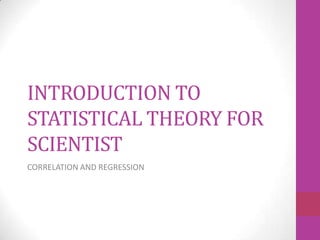
correlation and regression
- 1. INTRODUCTION TO STATISTICAL THEORY FOR SCIENTIST CORRELATION AND REGRESSION
- 2. • If we have question like “are two or more variables linearly related? If so, what is the strength of the relationship?” • Numerical measure used to determine whether two or more variables are linearly related and to determine the strength of the relationship. This measure called CORRELATION COEFFICIENT • There are two types of relationship; SIMPLE RELATIONSHIP AND MULTIPLE RELATIONSHIP.
- 3. • Statistical method used to determine CORRELATION whether a linear relationship between variables exist • Used to describe the nature of relationship REGRESSION between variables; positive/negative or linear/nonlinear • Have two variables; an independent SIMPLE variable (explanatory) and a dependent REGRESSION variable (response) MULTIPLE • Two or more independent variables where REGRESSION used to predict one dependent variable POSITIVE • Both variables increase or decrease at the RELATIONSHIP same time NEGATIVE • As one variable increase, the other variable RELATIONSHIP decrease and vice versa.
- 4. Scatter plots and Correlation • In order to find relationship between two different variables, data need to be collected. Example: relationship between number of hours study and grades for exam • Independent variable is variable that can be controlled or manipulated while dependent variable cannot • Dependent and independent variable can be plotted in graph named scatter plot • Independent variable x plotted on the horizontal axis while dependent y on vertical axis • Scatter plot is visual way to show the relationship between two variable
- 5. SCATTER PLOT is a graph of the ordered pairs (x,y) of number consisting of the independent variable x and dependent variable y Cars (in ten Revenue (in Company thousand) billion) A 63 7 B 29 3.9 C 20.8 2.1 D 19.1 2.8 E 13.4 1.4 F 8.5 1.5
- 6. Correlation • Correlation explained here is from Pearson Product Moment Correlation Coefficient (PPMC) by Karl Pearson Correlation coefficient computed from the sample data measures the strength and direction of a linear relationship between two quantitative variables. The symbol for the sample correlation is r while ρ (rho) for population correlation • Value range for correlation is from -1 to +1. • Correlation value which is close to +1 shows that there were a strong positive correlation while when the value is close to -1, it shows that there were a strong negative correlation • Value of r close to zero means that no linear relationship between the variable or only a weak relationship between both variables.
- 7. •
- 8. •
- 9. Regression • We previously test the significance of the correlation coefficient. If the correlation is significant, the next step is to determine the equation of regression line • LINE OF BEST FIT: best fit means that the sum of squares of the vertical distance from each point to the line is at minimum • Reason best fit needed is that the value of y will be predicted from the values of x; hence the closer the points to the lines, the better prediction will be
- 10. •
- 11. • MARGINAL CHANGE: the magnitude of the change in one variable when the other variable changes exactly 1 unit. • See example 10-9; the slope of the regression line is 0.106 which means for each increase of 10,000 cars, the value of y changes 0.106 unit ($ 106 million) on average. • EXTRAPOLATION: making prediction beyond the bounds of the data. • When prediction are made, they are based on present condition or on the premise that present trends will continue. • OUTLIER: point that seems out of place when compared with the other points • Some of this points can affect the equation of the regression line where the points are called influential points or influential observation
- 12. Coefficient of determination x 1 2 3 4 5 y 10 8 12 16 20
- 13. •
- 14. •
- 15. •
